Real Estate Market Confidence Shifts Due To COVID-19 According To New REINZ Report
The Real Estate Institute of New Zealand (REINZ) has today launched a new Residential Confidence Report which aims to understand the impact COVID-19 has had on the housing market and to track how the market is recovering. The report, based on weekly activity in the housing market, aims to look at the different factors in the market that indicate the level of confidence seen across the residential real estate profession. It will be issued monthly until we have a clearer picture of how the real estate market has responded to COVID-19.
The REINZ Residential Confidence Report for April has shown that activity in the real estate industry was extremely subdued due to COVID-19. In April $1.051 billion of residential property was sold across the country, whereas during a typical April month we would expect to see around $4.358 billion, showing the effect that Alert Level 4 lockdown had on the residential property market in New Zealand.
Unlike other recessions in living memory, such as the Global Financial Crisis in 2008, COVID-19 effectively hit New Zealand in a relatively short space of time with New Zealand’s first case recorded in late February and then just one month later the entire country was placed in lockdown. Therefore, this makes it extremely difficult to look at other recessions to assess what the impact might be on our economy but specifically the real estate sector.
Bindi Norwell, Chief Executive at REINZ says: “While confidence is important for those working in the real estate profession, confidence in residential property is also closely linked consumer spending patterns, borrowing behaviour and other activities such as individuals’ ability to pay off debt or make investment decisions. Therefore, we felt it was important to start measuring how some of the metrics that impact confidence have been performing.
“Naturally, some of the indicators became quite marked during April, including a dramatic drop in sales volumes and the percentage of auctions held – although this isn’t entirely surprising given the lockdown. Additionally, median days to sell and listings increased and there was a slight falling in the sales price to valuation ratio. However, prices held and, in fact the country experienced a record median price during April,” she continues.
“With some anecdotal evidence that May activity is showing some signs of recovery, that would indicate some positivity. However, with a few more months before the banks’ mortgage ‘holiday’ period comes to an end, it could be some time before we see the true impact on the market,” points out Norwell.
Number of properties sold drops to record low
The number of properties sold during April dropped to all-time record lows with just over 1,300 properties sold during April. Unsurprisingly, sales volumes dropped steadily over the four weeks, with the last two weeks of the month seeing just over 200 properties sold each week.
A ‘typical’ April month would see around 1,600 properties sold each week – even when the usual Easter break, school holidays and ANZAC Day are taken into account.
“It was no surprise that April’s sales figures were the lowest on record, but what was surprising was how many properties actually sold during lockdown, especially with some of the tough forecasts economists were predicting. With inspections, auctions and sales negotiations all having to be done virtually, it was impressive that real estate agents were able to complete in excess of 1,300 property sales in April,” says Norwell.
“Already, agents have reported a busy start to May trading, but time will tell whether this was a short-term peak of activity, or whether it is more sustained,” she continues.
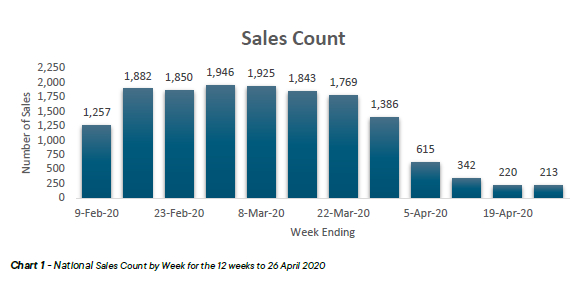
Median Days to sell increased during lockdown
The median number of days it took to sell a property steadily increased over the four weeks of Alert Level 4 lockdown from 27 days at the beginning of April to 42 days at the end of the month. This figure is more in line with the sort of data we see in January when the majority of the country is taking annual leave.
The highest median days to sell during April 2020 was Northland on 71 days and the lowest median days to sell was Manawatu-Wanganui on 22 days.
“Given that for all of April, bar three days, the entire country was in lockdown and unable to physically visit properties for sale, it’s not surprising that this figure slowly crept up over the month. With people keen to move on with their lives following weeks of lockdown, it will be fascinating to see if, and how, this metric changes as people came out of lockdown,” says Norwell.
“Our prediction is that this figure will drop in May, particularly in the early weeks, and then potentially start climbing back up as we move into June which is what we sometimes see as we head towards winter,” continues Norwell.

Median sales prices fluctuate throughout April
The median sales price of properties was extremely stable for the first three weeks of March at $650,000 and then it peaked in the final week of the month at $707,000. It was then quite volatile throughout April ending the month at a record median price of $732,786.
There are a number of stories currently being published where properties are selling for above CV, particularly in Auckland, but data over the coming months will confirm this or provide evidence to the contrary.
“From a buyer’s perspective, the biggest difficulty faced during a recession or crisis is how much to pay for a property and there tends to be a ‘fear’ around paying too much for a property as the market begins to find its new normal. Many people anticipate they will be able to get a ‘bargain’ following these sorts of events, so end up making offers far lower than a vendor may expect. This can sometimes end in a multi-offer situation where the reverse ends up happening, and the price of the property is driven up,” points out Norwell.
“Over the next few months it will be interesting to see what happens to median prices; some economists are predicting prices will fall up to 15% and others are predicting that the recession may not be as bad as initially estimated – particularly as unlike during the GFC we have very low interest rates. Unemployment levels will undoubtably affect pricing going forward, particularly when we come to the end of the mortgage ‘holiday’ period currently provided by the banks,” she continues.
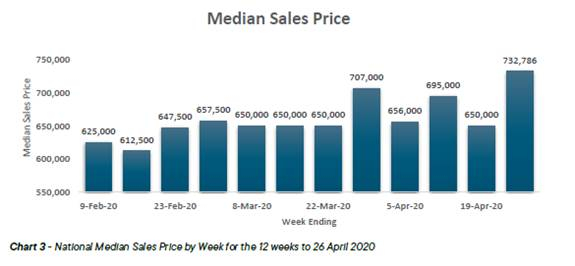
Median sales price to valuation ratio falls during April
Looking at the ratio of median sales price to valuation for New Zealand, the data showed us that it was at its lowest point for 12 months at the end of April with a ratio of 1.07, down from a high in the middle of March of 1.14. This meant that sales prices were higher than their CVs at the beginning of the month but moved closer to their CV by the end of April.
The sales price to valuation ratio can be a ‘polarising’ metric to look at, as it depends whether you are buying or selling. Naturally, if you are buying you want the ratio to be lower and if you are selling you want the ratio to be higher. It is also heavily influenced by how long ago a region updated its valuation figures.
“The slow decline in the price to valuation ratio has meant that over the last few weeks properties have been slightly more affordable for buyers during lockdown. It will be interesting to see how this ratio changes over the coming weeks, as anecdotal feedback from around the country suggests that demand for good properties remains high,” says Norwell.
However, if nothing on the supply side changes, we could see this figure start to increase. Though, it is important to note we are coming into the cooler months of the year and that real estate activity naturally tends to slow down as the weather cools down so it is important not to look at this measure in isolation,” points out Norwell.
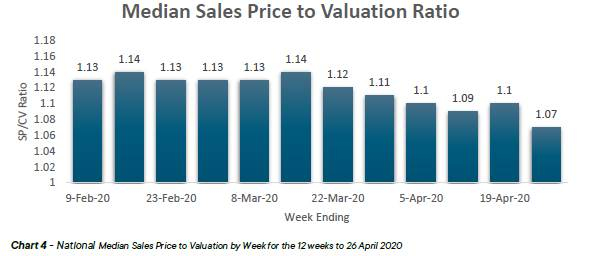
April represented lowest percentage of auctions for a non-January month on record
As the country went into lockdown the percentage of auctions held immediately halved from 20.6% at the end of March to 10.1% at the beginning of April. Then in the second week of lockdown the number lifted slightly to 12.0%, likely the result of those properties that had been seen by potential buyers before we went into lockdown. Moving through April, the percentage of auctions held each week declined, finishing at just 1.9% in the last week of the month.
The last week that the percentage of auctions across New Zealand was this low, was week commencing 15 January 2018 - typically the quietest time of the year with a significant portion of the country still on holiday.
“As some of our other indicators start to pick up and consumers start to feel that things are returning to ‘normal’, we would expect the number of auctions to pick up over the coming weeks. Already, anecdotal reports suggest that auction room activity is starting to pick up and that properties are selling under the hammer,” says Norwell.
“Part of the recovery of the housing market will come down to how people feel about buying and selling real estate, particularly by auction, how employment levels track over the coming months and whether people can get finance approval in order to bid at auction,” she continues.
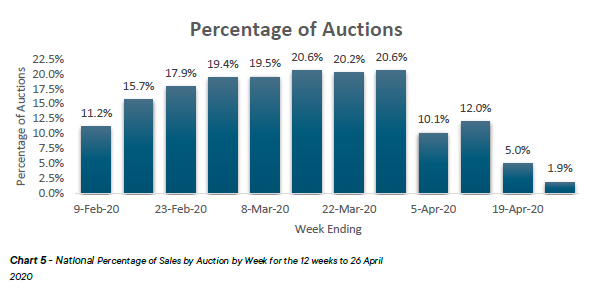
New listings showing early signs of growth
April saw just over 1,500 new properties listed for sale across New Zealand which is less than the number of listings we would normally expect to come to market in a week. Looking at the data shows us that in the last week of March, Kiwis were becoming increasingly concerned about COVID-19 with listings from the previous week more than halved (from 3,030 to 1,346 for the last week of March).
New listings for the first week of April were around one-third lower than the last week of March (from 1,346 to 482), steadily falling to a low of just 242 new listings in the third week of April.
“With access to some early May data, we can see that the number of new listings coming to the market has shown some early signs of recovery. Whether this is just an initial surge with people wanting a new house after being in lockdown for four weeks or signs of a recovery, this is a metric that will be watched very closely in the coming weeks,” concludes Norwell.
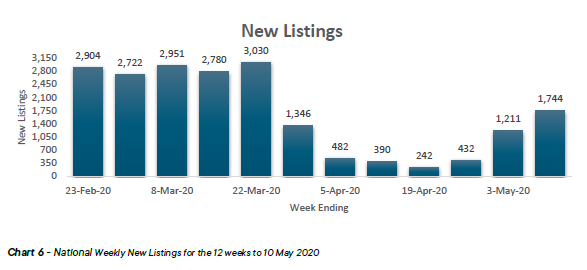


 Ipsos: New Zealanders Are Still Finding It Tough Financially; Little Reprieve Expected In The Next 12 Months
Ipsos: New Zealanders Are Still Finding It Tough Financially; Little Reprieve Expected In The Next 12 Months NZ Telecommunications Forum - TCF: Telecommunications Forum Warns Retailers About 3G Shutdown
NZ Telecommunications Forum - TCF: Telecommunications Forum Warns Retailers About 3G Shutdown PSA: Worker Involvement Critical In Developing AI For The Good Of Aotearoa
PSA: Worker Involvement Critical In Developing AI For The Good Of Aotearoa MBIE: Easter Trading Laws - Your Rights And Responsibilities
MBIE: Easter Trading Laws - Your Rights And Responsibilities The Conversation: As More Communities Have To Consider Relocation, We Explore What Happens To The Land After People Leave
The Conversation: As More Communities Have To Consider Relocation, We Explore What Happens To The Land After People Leave Bill Bennett: Satellite TXT expands, how Egmont Village got a fibre network
Bill Bennett: Satellite TXT expands, how Egmont Village got a fibre network



